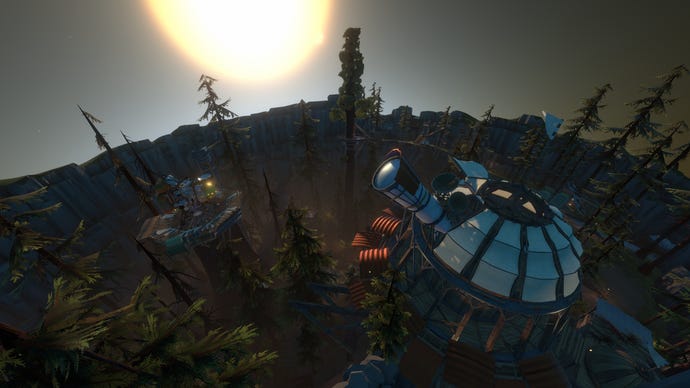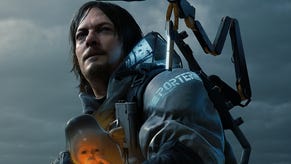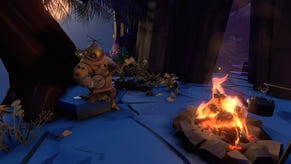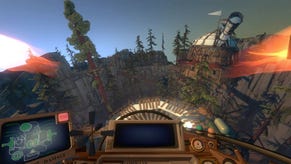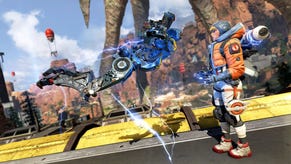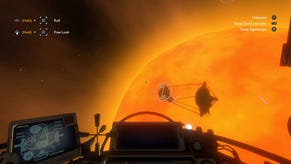From Student Project to Backpacking in Space: The Story Behind the Mystery Sci-Fi Outer Wilds
The seven-year road to the year's biggest surprise hit.
This article first appeared on USgamer, a partner publication of VG247. Some content, such as this article, has been migrated to VG247 for posterity after USgamer's closure - but it has not been edited or further vetted by the VG247 team.
Spoiler Warning: This piece discusses major spoilers for Outer Wilds. The developers of the game believe knowing as little as possible beforehand is the optimal way to play. The author wholeheartedly agrees. Stop here, go play Outer Wilds, and then come back. Trust us: it's worth it.

Outer Wilds is an origin story for Mobius Digital, even if it took the team seven years and 22 minutes to get there.
In 2011, then-University of Southern California student Alex Beachum was preparing a tech demo for one of his Interactive Media master classes. It begins on a strange planet falling apart around them, pieces of the surface break loose, plummeting into its exposed molten core. The player rushes to their spacecraft, entering from below, and quickly jets off into the black unknown of space. After some reorientation, they dodge monstrous angler fish to land on the shattered remains of some world covered in plants. They turn just in time to see the solar system's anchoring star go supernova.
You're only half-right if you think this sounds like Outer Wilds, an exploration game about a scrappy astronaut unraveling a cosmic mystery in a spacecraft held together by duct tape and gumption. This was instead the demo for Spaceworthy, a seed of an idea that would take seven years to bloom into Mobius Digital's first PC and Xbox One critical success. But the bones of Outer Wilds existed from the beginning, weathering acquisitions, crowdfunding, doubts, and mistakes to provide the foundation for one of 2019's best experiences.
NASA Meets Campfire
Beachum has always enjoyed exploration games. He's an unabashed Zelda fan and a self-proclaimed science nerd. When the time came to plot his thesis project, he wanted to marry those interests.
"They said it could be whatever you wanted, but you should try to push the medium forward, do something interesting," Beachum says. "I just wanted to see if I could make a spaceship that you could walk around inside of and fly around."

Loan Verneau, Beachum's friend and fellow student, assisted on the thesis in exchange for help on his own. This early iteration was essentially a collection of technical experiments and mood pieces accumulated during graduate school. One tasked the player with flying a model rocket before climbing into a full-sized version, raising the stakes in an attempt to "create a sense of nervousness in players." (Many of these demos would eventually be used to create the tutorial village on Timber Hearth.)
Another prototype sprung from his interest in quantum mechanics and how that could be implemented into a game. Disparate as the pieces were, Beachum was trying to evoke a feeling instead of telling a story.
"At the time, seven years ago, [exploration games] were sort of a dead genre. Elite: Dangerous wasn't out yet. Kerbal Space Program was barely a thing. No Man's Sky hadn't even been announced yet," Beachum says. "Let's make a space exploration game more in the vein of Apollo 13 or 2001: A Space Odyssey, where space is going to be extremely dangerous, and you're going to be very fragile."
He and Verneau aimed for a "NASA meets backpacking" tone, where the thrill of discovery is never without the threat of harm. Players should respect a "world that doesn't necessarily want you to explore" it, more apathetic in its immensity than explicitly antagonistic. They also wanted a world that changed dynamically in real time, whether the player was around to see it or not, forcing them to confront the fact that they "aren't the center of this universe."
They briefly flirted with the idea of making it a roguelike. "We knew you were going to play for some set amount of time, or you're going to have a run," Beachum says. Players would have the option of choosing a loadout that specialized in certain kinds of navigation, like climbing icy mountains or spelunking in a sandblasted cave system. "But it gradually became apparent that we weren't interested in procedural elements or building a procedural environment. We settled on this idea of having a handcrafted world subjected to procedural forces."
Whether players realized it or not, Brittle Hollow is the perfect example of this design philosophy. The team knew the planet would fall apart along the course of the 22-minute time loop, but how that destruction played out depended on the procedural whims of its volcanic moon, the Devil's Furnace. Once, the developers accidentally knocked the moon's orbit out of alignment while testing, which left Brittle Hollow's equator completely unscathed.
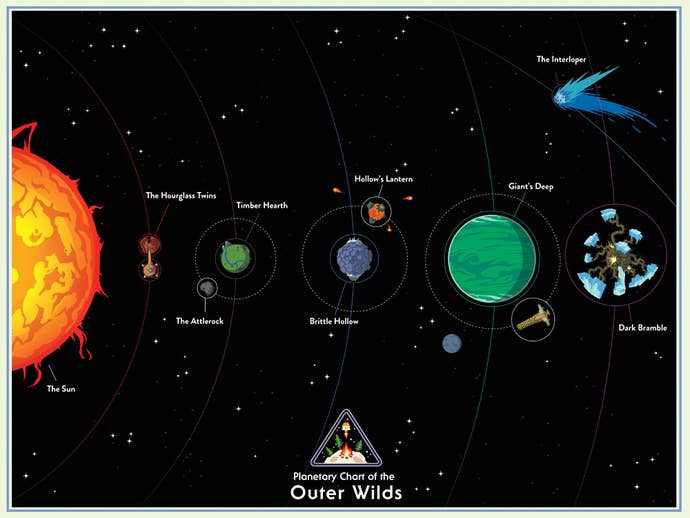
Eventually, Beachum and Verneau ditched all roguelike trappings beyond the run-based structure of a repeated cycle. Beachum had become enamored with weaving the mystery of the time loop into the narrative of the game. He laughed as he mentioned shamelessly emulating Majora's Mask, down to the musical sting as the world reset.
But Outer Wilds needed something more than an evocative tone, and Beachum was running short on time. "A month or two into the semester, I went up to a white board and scribbled a bunch of possibilities and one was the Hourglass Twins: one planet shrinks and another gets bigger and a beam connects them."
Brittle Hollow came together relatively quickly too, though the black hole at its center was instead once a system of volcanic vents. Giant's Deep was one of the last and least defined of the solar system's planets. Creating these strange and unique locations came easier than crafting a reason why players would want to visit.
"We did this weird tabletop DM session with paper versions of the planets. I was adlibbing flying between them, and from that these four major-we called them curiosities internally-emerged," Beachum says. The curiosities would become the four major mysteries around which Outer Wild's story revolved: The Ash Twin project, the Quantum Moon, the Vessel in Dark Bramble, and the Sunken Probe on Giant's Deep.
"Each one was going to have three clues, and once you knew them all you would be able to get to these curiosities. So, the idea of having these major secret locations that you could only access once you knew how to explore the environment was something we had early on."
This marked a critical shift in Outer Wild's development, elevating the game from an experiential sandbox to a knotted mystery where player curiosity propelled the narrative. Again, Beachum and Verneau looked to a Zelda title for inspiration.
"One thing [that] Wind Waker did really well that stuck to me was talking to characters who would tell you about other islands in the world," Beachum says. "There was a photographer with a gallery full of photographs of other locations that actually existed in the world." He wanted to stoke a similar drive to discover in his game through a seemingly natural process. "'Look at this ghost ship. I hope I get to go there at some point.' And sure enough, you do."
Throughout our discussion, Beachum speaks fervently about his (and eventually the team's) dedication to avoiding linear progress or a quest chain kind of narrative. If the world was built with enough thoughtful care and attention to detail, each player's natural curiosity should connect the clues and reveal the narrative tapestry. This alone set Outer Wilds apart from popular games at the time, but Beachum wanted to go further.
Launching Into Orbit
Outer Wilds existed in an alpha state for three years. Beachum would occasionally return to his project post-graduation to pick at its continued development. His sister, Kelsey Beachum, assumed much of the writing, and Verneau continued to support it, as well. They hoped to reach a commercially viable stage, eventually.
In 2015, Verneau approached Beachum with an offer to join him at Mobius Digital, a new development studio owned by actor Masi Oka (Heroes, Hawaii Five-0). Composer Andrew Prahlow and other original team members were also invited aboard. With renewed focus and all the resources that came with a team and studio, they prepared Outer Wilds for submission to the 2015 Independent Games Festival.
The team won the award for Excellence in Design, and knew then the game had to be finished. In hindsight, their largest hurdle was not realizing the full scope of the project. Beachum says if you squint at their submission for IGF 2015, much of the intentions are present but with none of the execution players see in 2019's release.
"After a year at Mobius, I was really, really nervous with where we were in terms of... well, everything," he said. "The game didn't feel right at that point for a lot of different reasons. We were working on all the individual pieces and were praying they would all fit together in the end."
The addition of the Nomai, the ancient alien refugees who rebuilt a shadow of their society within the solar system of Outer Wilds, was an object lesson in ballooning design scope. Far more technologically advanced than the playable Hearthians, the team lost the thread of their "backpacking in space" inspiration and landed in the weeds of futuristic science fiction. The plan was to reskin the game and polish the text in order to finally prepare for release.
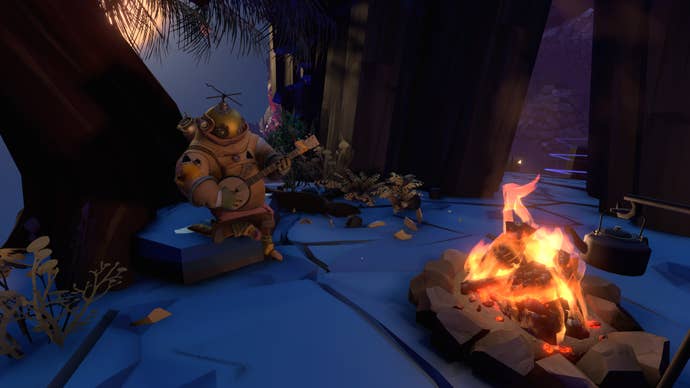
Instead, the fortuitous launch of crowdsourcing platform Fig, and their honor of being selected as the first featured game, provided another path. With additional capital and feedback, the team could once again reevaluate what was possible. Looking back, it was as much a curse as a blessing.
"I am very glad we never had to release the version of the game we were planning, the one between alpha and where we finally ended up," Beachum says. "The whole game ended up being a more complicated process than even I imagined."
The team stepped back to regroup and refocus on the vision of roasting marshmallows over a campfire as the universe dies around you. Simple art replaced the gray placeholder boxes, and a threadbare plot connected all the disparate Curiosities. Despite that, the technical immensity of Outer Wilds grew larger every day. They could only test individual planets: too much was happening for the solar system to exist all at once. The team knew there was a real chance they would never finish development.
Two other projects, both released on mobile, kept the team busy as months stretched into years. The puzzle RPG Terra Chroma, along with the exploration-focused Beacon 38, provided vital development experience. Public interest in Outer Wilds stayed strong, helped by a free alpha release. A dedicated community flourished around the game, who created wikis and postulated the unfinished mysteries.
Annapurna Interactive purchased the publishing rights from Fig in 2018, and Beachum says it provided a much needed shot in the arm for the team. They began working on a third pass at art, writing, and critical systems. He specifically commends the art team, who produced most of the final art in the year between Annapurna's involvement and final release.
Everyone was feeling much better about the chances of success.
Rumors and Player Interest
Beachum's largest moment of doubt came in February of 2018. They had just finished their worst playtest of the game to date. Players were meant to investigate a piece of Nomai technology that crashed into the planet. It would provide a map of the solar system and the first clues to the game's larger mysteries. But most wandered aimlessly around the starting village, saying they didn't know what to do or else not caring enough to ever step beyond the lip of the crater.
"Our critical mistake was expecting people to be interested in this thing that fell out of the sky, but the village was just as new and interesting to players. They had no reason to prioritize the main story and had no idea where to go or what to do," Beachum says. "I remember being pretty bummed out. We can't release this. This is not going to work. What are we going to do?"
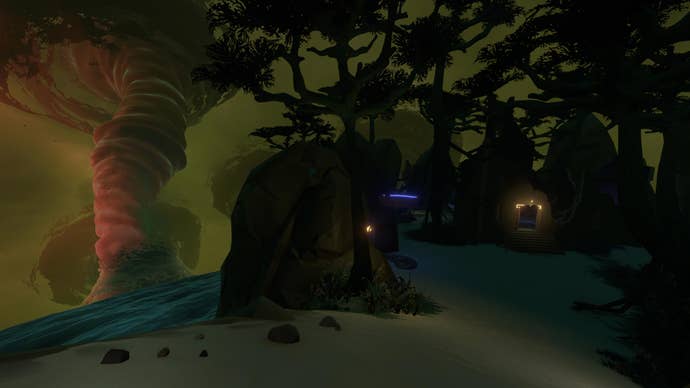
The team met in crisis, and someone suggested an unorthodox solution: their design documents, which resembled a gumshoe detective's connection map. Flowcharts, concept art, notes and more created a web-like simulation of Outer Wild's interconnected Curiosities. Why not create a version of the ship's onboard computer to reflect the internal design structure?
The new Rumor Mode, implemented in just a few weeks, tracked player discoveries, uncovering connections and providing circumspect hints about where to visit next or when there might be more to find on each planet. It has been hailed by critics as one of the game's best systemic additions.
Beachum admits he thought it would severely undercut the game's natural flow. "We needed to add it, but I was worried about players feeling like they were just following a trail and losing the sense that they were doing things for themselves. Above all, I didn't want it to feel like a standard quest system."
It helped solve a recurring problem with their playtesting. In a game where players could do anything, how did they test particular scenes? Guide them instead, and they lose the magic. The Rumor Mode struck a balance that especially helped onboard those unaccustomed with the structure of traditional adventure games.
"We had a player who admitted to being mostly a Call of Duty fan, and at the end of the playtest he said, 'I kind of want to go learn more about quantum mechanics,'" Beachum says.
Connecting the dots that revealed the thousands-years-old tragedy at the center of Outer Wilds' story was aided by the writing direction of Kelsey Beachum. Her onerous task was to convey plot-critical information to players in a way that revealed the precise amount of information, while also weaving in lore, tone and characterization. Oh, and it couldn't distract from the exploration side of the game.
Aiding her task was an overarching design ethos regarding the distribution of clues. Each location should provide only one clue, keeping players from becoming overwhelmed. For example, the entire purpose of the Quantum Tower on Giant's Deep is to teach you one of three rules for reaching the Quantum Moon.
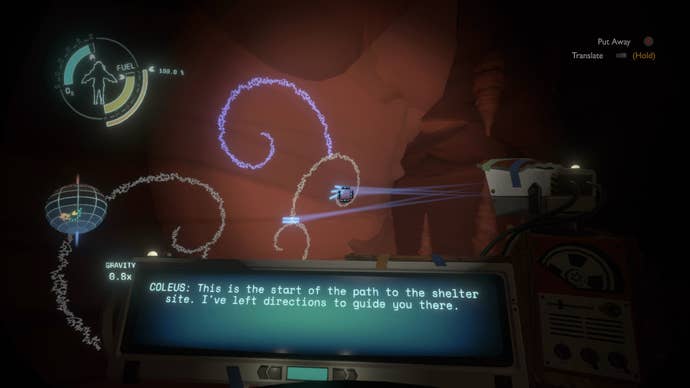
The team was proud they only occasionally broke this rule. As circuitous as your path through Outer Wilds' time loops may be, they believed it should always feel like a journey of constant forward progression. Wherever players look, what they find isn't just interesting. It's critical information.
"In my mind, the biggest verb in Outer Wilds is observation," Beachum says. "We kept leaning into that in a lot of different ways. You look at the Nomai technology to make it work. Players have a telescope, a probe that can take photos, your ship has three cameras. There's all this diegetic information. And then, of course, all of the quantum laws. Every facet of the game is woven into the idea that what the player is looking at really, really matters."
Reflecting on the Journey
Outer Wilds launched in May 2019, after seven years in production and through three separate acquisitions or investments. The good fortune that led to such a moment isn't lost on Mobius Digital.
I ask him if the team encountered anything in that seven year period that affected development. That's a long time for other media to sneak in and change the core vision. Surprising for a team full of Zelda fans, they avoided playing Breath of the Wild. Fearful about losing countless hours to it, Beachum also wondered if it was drawing inspiration from Wind Waker in the same way he had.
"Having played it now, I do think both games are trying to solve similar problems in very different ways. They leaned into characters telling you about interesting things, but they don't put any markers on your map. Players have to go explore and find out," Beachum says. "I was interested to see where both ended up in isolation from each other."
He discusses his strong distaste for 2011's Skyward Sword and how he considers Breath of the Wild turning away from the older "hand holding" design philosophy of Zelda games. Given the initial idea for Outer Wilds cropped up around the same time, it's hard not to wonder if Beachum developed his own refutation.
"Even when you compare it to all of these games that have come out in the meantime, No Man's Sky, Breath of the Wild, which have done their own things in a similar space, we can just add to that conversation," Beachum said. "I'm certainly happy to see an uptick in exploration-based, player-driven games in recent years. I hope we wind away from the triple-A open-world, 'you can't actually see the map for all the quest markers' approach."

When asked about the team's thoughts on making a non-violent game, he says guns were never on the table. "It was always a mystery game about exploring. The goal was to do something that captured the spirit of real world exploration. I hope we don't send a bunch of guns into space. I hope it continues to be humans reaching out into the universe and trying to understand it, not killing everything they find. [...] If you're making a game all about natural forces and overcoming challenges by understanding those forces, it doesn't make sense to kill the anglerfish."
Mobius Digital is currently engrossed in bug fixing and patches, and beyond that bringing Outer Wilds to as many platforms as possible. But that hasn't stopped them from already looking forward to its next project.
"I think if there is one thing our studio is now very good at, it's piquing player curiosity and then giving them the tools to investigate on their own," Beachum says. "We're interested in making things where players are interested in figuring things out for themselves."
